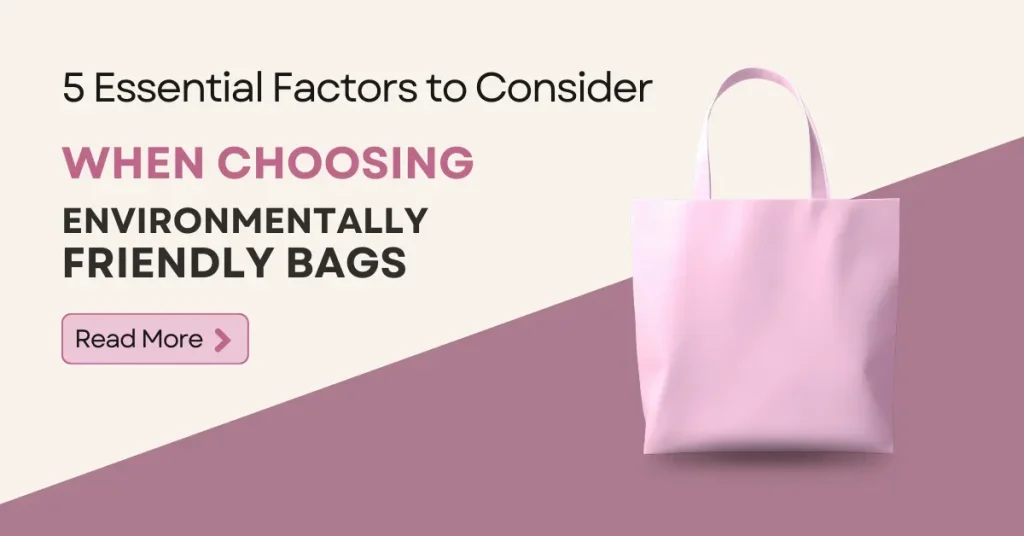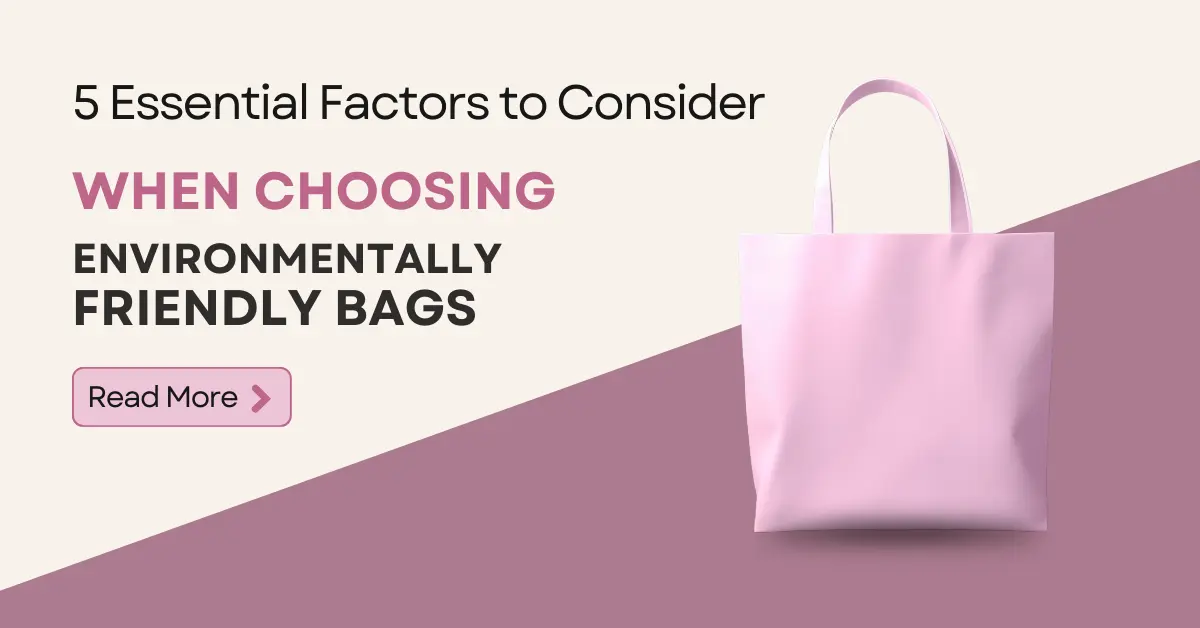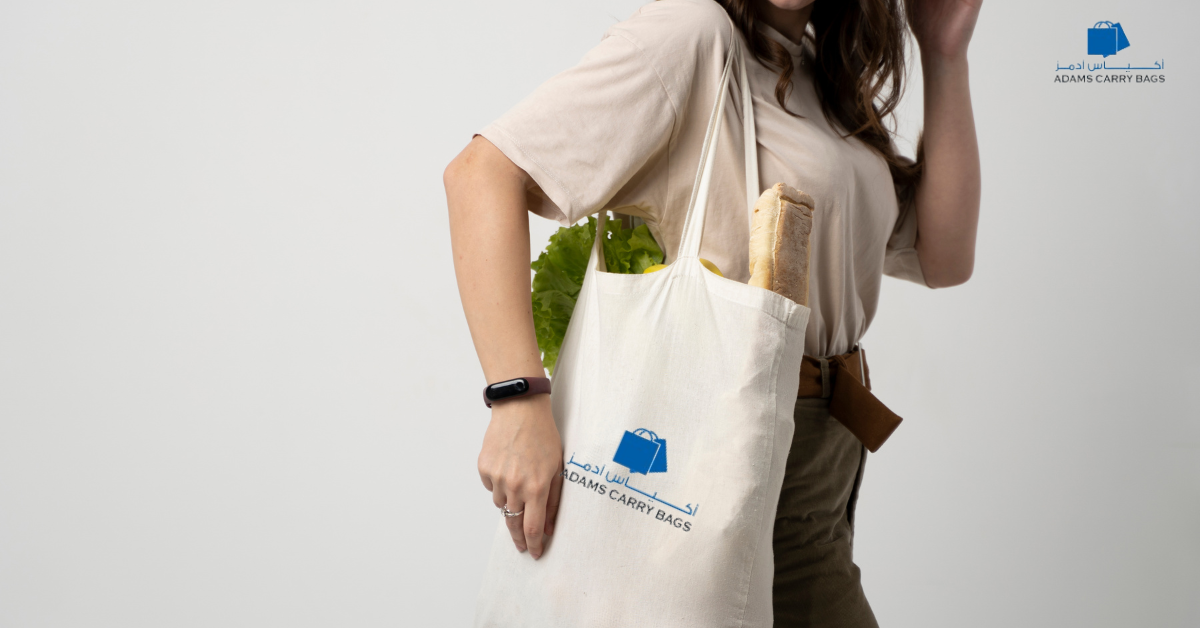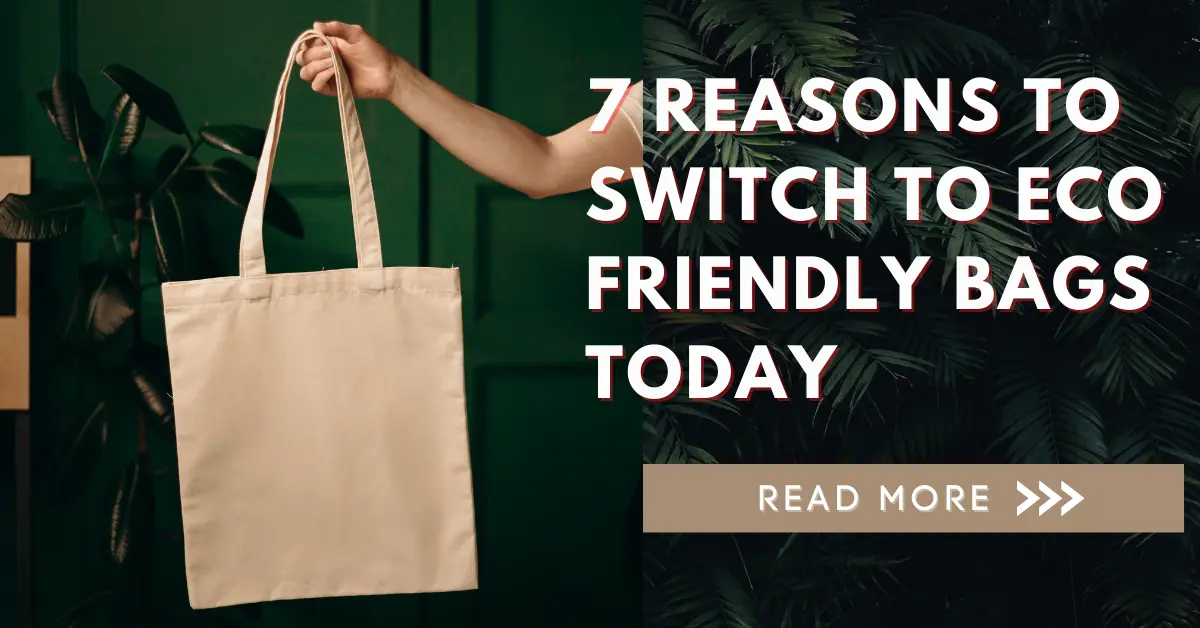
The journey to a greener planet starts with everyday choices, and sometimes the smallest changes can make the biggest impact. One of the simplest and most effective ways to reduce our environmental footprint is by switching from single-use plastic bags to environmentally friendly bags. These eco-friendly alternatives are designed to minimize waste, reduce pollution, and promote a more sustainable lifestyle.
The significance of using reusable, durable, and innovative bags has increased over the years, driven by growing environmental awareness and government regulations that aim to curb plastic pollution. This shift is particularly noticeable in regions like Dubai, where sustainability is more than just a buzzword; it’s a way of life. Dubai’s commitment to reducing waste and promoting green practices has led to a surge in demand for ecofriendly bags that not only meet practical needs but also align with sustainability goals.
In this comprehensive guide, we’ll dive into the five essential factors to consider when choosing these Environmentally Friendly Bags. We’ll explore the materials that make them sustainable, the durability that ensures they last, the innovative designs that make them versatile, the environmental impact they have, and the regulations and certifications that ensure they meet the highest standards. Whether you’re in Dubai or anywhere else in the world, these insights will help you make an informed choice and contribute to a greener planet. Let’s get started on this journey toward a more sustainable future.
1. Material and Sustainability
The first and foremost factor to consider when choosing environmentally friendly bags is the material they are made from. Traditional plastic bags, the kind you often find at supermarkets or convenience stores, are infamous for their detrimental impact on the environment. These bags can take hundreds of years to decompose, clogging landfills, polluting oceans, and harming wildlife. In fact, a single plastic bag, if not properly disposed of, can remain in the environment for generations, breaking down into microplastics that pose even more threats to ecosystems.
On the other hand, non-woven carry bags offer a sustainable alternative. These bags are typically made from recycled materials, such as polypropylene, which is not only durable but also has a significantly lower environmental impact compared to traditional plastics. The non-woven construction process involves bonding fibers together without weaving, creating a fabric-like material that is both lightweight and strong.
What makes these bags even more eco-friendly is their reusability. Unlike single-use plastic bags that are often discarded after a single trip to the store, non-woven carry bags are designed to be used over and over again. This feature significantly reduces waste and helps conserve valuable resources. By reusing a single non-woven bag, you can prevent the need for dozens, if not hundreds, of plastic bags, thereby reducing your carbon footprint.
Choosing bags made from recycled or sustainable materials is a small but impactful step toward a greener planet. It aligns with a broader shift in consumer behavior, where people are becoming more conscious of their choices and their impact on the environment. By selecting non-woven carry bags, you’re not just making a practical choice; you’re also making a statement that you care about the planet and are committed to reducing waste. This makes them an ideal choice for environmentally conscious individuals and businesses a like.
Non-Woven Fabric
Non-woven grocery bags are gaining popularity due to their durability and sustainability. They are made from polypropylene, which is recyclable and has a lower environmental footprint compared to traditional plastics. The manufacturing process involves bonding fibers without weaving, resulting in a strong yet lightweight material.
Other Sustainable Materials
While non-woven fabric has become a popular choice for environmentally friendly bags, there are other sustainable materials that offer their own unique benefits. Each material contributes to a greener planet in its own way, and understanding their characteristics can help you make an informed choice when selecting your reusable bags.
Cotton, for example, is widely appreciated for its breathability and comfort. It is a natural fiber that is biodegradable, which means that when a cotton bag reaches the end of its life, it won’t linger in landfills for decades. Cotton’s breathability makes it an excellent choice for carrying items that need ventilation, like fruits and vegetables. Additionally, cotton bags can often be machine-washed, adding to their reusability and longevity.
Jute, known as the “golden fiber,” is another sustainable option. It is derived from plants and is completely biodegradable. Jute bags are strong and versatile, making them ideal for carrying heavier items. This fiber is also highly renewable, as jute plants grow quickly and require minimal pesticides and fertilizers. In regions where jute is cultivated, its production supports local economies, adding a socio-economic benefit to its Environmentally Friendly Bags credentials.
Hemp is a powerhouse of sustainability. It is incredibly durable and requires minimal resources to grow. Hemp plants need less water and fewer chemicals than other crops, making them an eco-friendly choice from cultivation to production. Hemp’s strength ensures that bags made from this material can endure heavy use without showing signs of wear and tear. This makes hemp bags a reliable option for those who need a reusable bag that can handle rigorous use over a long period.
When choosing reusable bags, it’s essential to consider the environmental impact of the material. While all three materials—cotton, jute, and hemp—are generally more sustainable than traditional plastics, they each have unique environmental footprints. Cotton, for instance, can be water-intensive to grow, while jute and hemp have lower water requirements. Understanding these nuances can guide you toward the most eco-friendly choice that aligns with your values and usage needs.
In summary, when exploring environmentally friendly bags, consider not only their durability and versatility but also their origin and end-of-life impact. Each sustainable material has its advantages, and by choosing wisely, you can contribute to a more sustainable future while enjoying a high-quality, reusable product.
2. Durability and Reusability
Durability is another critical factor when considering Environmentally Friendly Bags, as it directly influences their environmental impact and long-term sustainability. Eco-friendly bags should be designed to endure repeated use, holding up against wear and tear without degrading prematurely. This robustness ensures that you get the most use out of a single bag, reducing the need for replacements and, consequently, minimizing waste.
When evaluating the durability of environmentally friendly bags, it’s important to consider various aspects of their construction. Start by examining the quality of the stitching. Sturdy, reinforced seams are a strong indicator of a well-made bag. Bags with double-stitched or bar-tacked seams are less likely to unravel, ensuring they remain functional even when carrying heavy loads.
The material used is another key component of durability. Non-woven carry bags are designed with strength in mind, using tightly bonded fibers that resist tearing. Similarly, cotton, jute, and hemp bags are known for their resilience, withstanding the rigors of everyday use. In fact, bags made from these materials often improve with age, becoming softer without losing strength.
Handles are often a weak point in reusable bags. To ensure durability, look for bags with reinforced handles, preferably those that are stitched into the body of the bag rather than simply glued or attached superficially. This type of construction allows the bag to support more weight without the risk of the handles snapping off, a common issue with lower-quality bags.
Another aspect to consider is how well the bag holds up to cleaning and maintenance. Durable bags should be easy to clean, whether by hand-washing or machine-washing, without losing shape or integrity. This feature is particularly important for reusable bags, which are often used to carry food items and groceries. A bag that can be cleaned and reused regularly contributes to sustainability by reducing the need for disposable alternatives.
Finally, consider the bag’s ability to withstand environmental factors. Environmentally Friendly Bags should be resistant to moisture, heat, and sunlight. This is especially relevant in places like Dubai, where temperatures can soar, and conditions can be harsh. A durable bag should not warp, fade, or degrade when exposed to these elements.
In summary, durability is a cornerstone of environmentally friendly bags, playing a significant role in their sustainability. By choosing bags that are built to last, you not only get more value from each bag but also contribute to a reduction in overall waste. Durable bags are a practical choice for anyone committed to living more sustainably, offering the perfect balance between strength, longevity, and eco-friendliness.
Testing for Durability
Before purchasing, it’s important to test the bag’s durability. Consider the stitching, handles, and overall construction. A high-quality bag will have reinforced seams and sturdy handles. This ensures that the bag can carry heavy loads without ripping.
Reusability in Everyday Life
The true beauty of reusable bags is their versatility. A well-designed reusable bag should be adaptable enough to suit a wide range of needs, from a quick trip to the grocery store to a day at the beach. This flexibility is what makes them such a valuable alternative to single-use bags, driving a more sustainable lifestyle and reducing the demand for disposable products.
When we think about versatility, it’s not just about size or capacity; it’s about the bag’s ability to accommodate different types of items and scenarios. A versatile bag can carry groceries one day and gym clothes the next. It can be used to transport a laptop and work essentials or packed with snacks and drinks for a picnic. This adaptability means that a single reusable bag can replace dozens of plastic bags, significantly reducing waste.
Another aspect of versatility is design. Many reusable bags feature multiple compartments, which add functionality. These compartments allow you to separate items, keeping fragile goods like eggs and bread from getting crushed by heavier items like cans or bottles. Some bags even come with insulated sections, making them perfect for carrying cold or frozen foods.
Versatility also encompasses portability. A great reusable bag should be easy to carry and store when not in use. Foldable or collapsible designs are particularly useful, as they can be tucked into a pocket or purse, ready to be pulled out when needed. This makes it more likely that you’ll have your reusable bag on hand, reducing the temptation to use single-use plastic bags.
Durability plays a role in versatility as well. A bag that’s built to last can be used in a variety of settings without fear of it breaking or tearing. This robustness allows you to use the same bag for multiple purposes over time, further contributing to its sustainability. Whether it’s carrying heavy groceries or serving as an impromptu overnight bag, a durable reusable bag can handle it all.
The more reusable a bag is, the less need there is for disposable alternatives. This contributes to a greener environment by reducing waste and conserving resources. It also aligns with a growing trend toward minimalism and conscious consumption, where people are seeking products that offer long-term value and versatility.
Ultimately, a versatile reusable bag is an investment in a more sustainable future. By choosing a bag that can adapt to various needs, you not only simplify your life but also play a part in reducing plastic waste and promoting a cleaner planet. The versatility of these bags makes them a smart choice for anyone looking to embrace a more eco-friendly lifestyle.
3. Innovative Design and Functionality Environmentally Friendly Bags
Design and functionality are essential when it comes to choosing environmentally friendly bags. These bags serve as a statement of your commitment to sustainability, but they also need to fit into your daily routine seamlessly. A bag’s design should strike a balance between aesthetics and practicality, providing a product that not only looks good but also meets the demands of everyday life.
Aesthetics are important because they influence whether people will actually use the bag. A stylish design with appealing colors or patterns can make you more likely to carry it around, which in turn reduces the use of single-use bags. Moreover, a well-designed bag can complement your personal style, allowing you to showcase your eco-friendly values while staying fashionable.
However, a great design is more than just good looks—it must also be functional. Functionality in environmentally friendly bags involves considering how the bag will be used in real-world scenarios. For example, a reusable bag designed for grocery shopping should have ample space for carrying food items, with sturdy handles that make it easy to carry heavy loads. Extra pockets or compartments can be valuable for organizing smaller items, reducing the risk of spillage or damage during transit.
Functionality also involves the bag’s ease of use. Can it be folded or collapsed for easy storage? This feature is particularly useful when you need to carry a bag with you but don’t want it to take up much space. A bag that can be easily stashed in a pocket or purse is more likely to be used, ensuring you always have a reusable option on hand.
Another aspect of functionality is the Environmentally Friendly Bagsversatility. Can it serve multiple purposes, from shopping to travel to everyday errands? A bag that can adapt to various situations is more likely to become a staple in your routine, reducing the need for additional bags or accessories.
Durability is a critical component of functionality. A well-designed bag should be built to last, with reinforced seams and high-quality materials that can withstand frequent use. This durability ensures that the bag remains functional over time, reducing the need for replacements and contributing to sustainability.
Incorporating innovative design elements can further enhance functionality. Features like insulated compartments, adjustable straps, or waterproof linings can make an environmentally friendly bag even more useful in a variety of situations. These innovations can transform a simple reusable bag into a multi-functional accessory, making it a go-to choice for many different activities.
In summary, a well-designed environmentally friendly bag should be aesthetically pleasing and highly functional. It should be stylish enough to encourage regular use while offering practical features that make it suitable for everyday tasks. By focusing on design and functionality, you can choose a Environmentally Friendly Bags that not only supports your eco-friendly goals but also becomes an indispensable part of your daily life.
Innovative Features
Look for innovative features such as foldable designs, extra pockets, or insulated compartments. These features enhance the bag’s functionality and encourage regular use. Non-woven carry bags with unique designs can be a conversation starter, promoting eco-friendliness to a broader audience.
Customization Options
Customization is a significant factor when choosing non-woven grocery bags, especially for businesses looking to make a statement while promoting sustainability. The ability to customize bags with unique designs and branding offers an opportunity to create a personalized touch that resonates with customers and aligns with a company’s environmental values.
Custom designs can transform ordinary reusable bags into powerful marketing tools. Businesses can incorporate their logos, taglines, or brand colors into the design, turning the bag into a walking advertisement. This is particularly useful in places like Dubai, where brand visibility is crucial in a competitive market. Customization allows companies to maintain brand consistency across all their marketing materials, creating a cohesive and recognizable identity.
For businesses in Dubai, which is a hub for commerce and tourism, custom-branded non-woven grocery bags offer a way to reach a wider audience. Tourists and locals alike can carry these bags, spreading the company’s brand throughout the city and beyond. It’s a cost-effective marketing strategy that aligns with sustainability goals, as reusable bags reduce the need for single-use plastics.
Customization also allows businesses to communicate their commitment to sustainability. By offering eco-friendly bags with custom branding, companies can showcase their dedication to reducing waste and promoting a greener future. This resonates with consumers who prioritize sustainability and are more likely to support brands that align with their values. A custom-branded bag can convey a sense of responsibility, encouraging customers to reuse the bag and reduce their environmental impact.
Moreover, customization can go beyond simple branding. Companies can add unique features to their bags to enhance functionality and appeal. For example, a bag designed for a tech company might include a padded laptop sleeve, while a health-focused business might opt for a bag with insulated compartments for carrying food or drinks. These additional features add value for customers and encourage regular use of the bag.
Another advantage of customization is the opportunity to engage with customers on a deeper level. Companies can use custom designs to tell a story or convey a message about their sustainability efforts. This narrative approach can foster a stronger connection with customers, making them more likely to choose the company’s products or services.
In summary, customization is a powerful tool for businesses seeking to promote their brand while supporting sustainability. Custom-branded Environmentally Friendly Bags offer a versatile and eco-friendly marketing solution that aligns with Dubai’s commitment to sustainability. By incorporating unique designs, logos, and innovative features, businesses can create reusable bags that not only promote their brand but also contribute to a greener environment.
4. Environmental Impact and Carbon Footprint
Understanding the environmental impact of a bag is crucial when you’re striving to make sustainable choices. This means looking at the entire lifecycle of the bag—from its production and use to its eventual disposal—to get a clear picture of its true ecological footprint. The ultimate goal is to select bags that have a minimal carbon footprint, ensuring that your choice contributes to a greener planet.
The lifecycle of a bag begins with its production. This is where the environmental impact is often the greatest, depending on the materials and energy used. For example, traditional plastic bags require fossil fuels for their production, resulting in significant carbon emissions. Additionally, the manufacturing process for plastic bags involves toxic chemicals that can harm the environment. By contrast, environmentally friendly bags like Environmentally Friendly Bags are often made from recycled materials or plant-based sources, reducing the carbon footprint from the start.
Beyond materials, it’s also essential to consider the energy used in production. Environmentally Friendly Bags made in facilities that rely on renewable energy sources, such as solar or wind power, tend to have a lower environmental impact. Some manufacturers implement energy-efficient processes or offset their carbon emissions, further reducing the carbon footprint of the final product.
After production, the next stage in the bag’s lifecycle is its use. A durable, reusable bag is inherently more sustainable than single-use alternatives because it reduces waste and decreases the need for constant manufacturing. However, the number of times a bag is reused also plays a role in its environmental impact. The more you reuse a bag, the more its initial environmental cost is spread over time, making it more eco-friendly.
Cleaning and maintaining the bag is another aspect to consider. Some reusable bags require specific care, such as hand-washing, which might consume more resources. However, many eco-friendly bags are designed for easy maintenance, allowing them to be cleaned and reused without excessive water or energy use.
Finally, consider the bag’s end-of-life disposal. An environmentally friendly bag should ideally be recyclable or biodegradable, ensuring it doesn’t end up in a landfill or contribute to pollution. Environmentally Friendly Bags made from non-woven materials can often be recycled, while those made from natural fibers like cotton or jute are biodegradable. It’s crucial to understand how the bag will be handled at the end of its lifecycle and whether it will contribute to environmental degradation or be repurposed into new products.
By considering the entire lifecycle of the bag, you can make informed choices that minimize environmental impact. Opting for bags with a low carbon footprint not only supports sustainability goals but also aligns with a broader commitment to reducing waste and conserving resources. In this way, every step in the lifecycle contributes to a cleaner, greener planet, emphasizing the importance of choosing wisely when it comes to environmentally friendly bags.
Life Cycle Analysis
A thorough life cycle analysis helps determine a bag’s environmental impact. This analysis considers factors like energy use during production, transportation emissions, and the bag’s end-of-life options. Ecofriendly bags that are recyclable or biodegradable have a lower carbon footprint.
Reducing Waste
Choosing durable and high-quality bags is a simple yet effective way to reduce waste over time. The idea is straightforward: if a bag can withstand the rigors of everyday use for an extended period, it eliminates the need for frequent replacements, thus reducing overall consumption and waste production. This concept has a significant environmental impact, contributing to a more sustainable future.
When a bag is designed to be durable, it’s not just a cost-saving measure—it represents a commitment to sustainability. High-quality materials and construction ensure that a bag can endure heavy loads, frequent use, and even the occasional spill without falling apart. This robustness is critical because it means a single bag can serve you for years, reducing the number of bags you need over time. This translates to fewer resources consumed in manufacturing, fewer products shipped and sold, and less waste ending up in landfills.
Durable bags also align with Dubai’s sustainability goals. As a forward-thinking city with a strong focus on environmental stewardship, Dubai has set ambitious targets for reducing waste and promoting sustainable practices. By choosing bags that are built to last, residents and businesses in Dubai contribute to these goals, demonstrating that a greener lifestyle is achievable through thoughtful choices.
Furthermore, the durability of high-quality bags encourages a mindset of reusability. When people have a reliable bag they can count on, they are less likely to turn to single-use plastic bags, which are known for their harmful impact on the environment. This shift from a disposable culture to a reusable one is a crucial step in reducing plastic waste and promoting a circular economy, where products are designed to be reused and recycled.
The benefits of durable bags extend beyond the environment. High-quality bags offer greater functionality and versatility, making them suitable for a range of uses. Whether you’re heading to the grocery store, packing for a weekend trip, or carrying supplies for work, a durable bag can handle it all. This versatility means you can rely on the same bag for different tasks, further reducing the need for multiple bags and contributing to a simpler, more sustainable lifestyle.
In summary, choosing durable and high-quality bags is an investment in both your future and the planet’s. By selecting bags that are built to last, you reduce waste, conserve resources, and support Dubai’s sustainability initiatives. It’s a win-win situation that benefits both the environment and your daily life, illustrating that small changes can have a big impact when it comes to promoting a greener, more sustainable world.
5. Compliance with Regulations and Certifications
In many regions, including Dubai, there are regulations and certifications that govern environmentally friendly products. These regulations are designed to ensure that companies adhere to specific environmental standards, promoting sustainability and minimizing negative impacts on the environment. For environmentally friendly bags, compliance with these standards is crucial to demonstrate their eco-friendliness and ensure they are safe for consumers and the planet.
Regulations in Dubai and other regions often focus on reducing plastic waste, encouraging recycling, and promoting the use of sustainable materials. As a city known for its progressive approach to sustainability, Dubai has implemented various measures to reduce the reliance on single-use plastics. For example, the government has introduced policies to restrict the use of plastic bags and promote reusable alternatives. When selecting environmentally friendly bags in Dubai, it’s important to ensure they meet these regulations to avoid penalties and contribute to the city’s sustainability goals.
Certifications are another important aspect of compliance. These certifications provide a way to verify that a product meets certain environmental standards. Common certifications for eco-friendly bags include ISO (International Organization for Standardization), FSC (Forest Stewardship Council), and Fair Trade. ISO certifications often focus on quality management and environmental management systems, indicating that the manufacturing process is sustainable and meets international standards. FSC certification is particularly relevant for bags made from wood-based products, ensuring the materials come from responsibly managed forests.
Fair Trade certification goes beyond environmental concerns, addressing social and ethical issues in the supply chain. Bags with this certification indicate that the workers involved in production were treated fairly and that their working conditions meet ethical standards. This adds an extra layer of assurance for consumers who want to support products that are not only environmentally friendly but also socially responsible.
When choosing environmentally friendly bags, it’s essential to check for these certifications and ensure the bags comply with relevant regulations. This step provides peace of mind, knowing that the bags are truly eco-friendly and align with sustainability goals. It also demonstrates a commitment to supporting businesses and practices that prioritize the environment and ethical considerations.
Compliance with regulations and certifications can also influence customer perception. Consumers are increasingly conscious of the environmental impact of their choices, and they often seek products that align with their values. By choosing bags that meet strict environmental standards, you can attract environmentally conscious customers and build a reputation as a responsible business or consumer.
In summary, ensuring compliance with regulations and certifications is a critical step when choosing environmentally friendly bags. These standards help guarantee that the bags are truly sustainable, safe, and ethically produced. By selecting bags that meet these requirements, you not only contribute to a greener environment but also align with the growing trend toward sustainability and ethical practices.
Government Regulations
Dubai has implemented various regulations to promote sustainability. These regulations may affect the use of plastic bags and promote eco-friendly alternatives. When choosing non-woven carry bags, ensure they meet the local regulatory requirements.
Certifications and Standards
When shopping for environmentally friendly bags, it’s crucial to look for certifications that validate the bag’s eco-friendliness. These certifications serve as a guarantee that the product has undergone rigorous testing and meets specific environmental and ethical standards. By choosing bags with these certifications, you add credibility to your choice and ensure that you are actively supporting sustainable practices.
Among the most widely recognized certifications are ISO, FSC, and Fair Trade. Each certification focuses on a different aspect of sustainability, offering a comprehensive view of the bag’s environmental impact and ethical implications.
ISO (International Organization for Standardization) certifications are renowned worldwide for setting rigorous benchmarks in various industries. For environmentally friendly bags, ISO certifications often relate to quality management and environmental management systems. These certifications confirm that the manufacturing process adheres to international standards, indicating that the production of the bag is efficient, sustainable, and safe for the environment. An ISO certification can also suggest that the bag is produced in a manner that minimizes waste, conserves energy, and reduces harmful emissions.
The Forest Stewardship Council (FSC) certification is particularly important for bags made from wood-based products or paper. FSC ensures that the materials used in production come from responsibly managed forests. This certification guarantees that the forest resources are being harvested sustainably, with a focus on conservation and reforestation. An FSC-certified bag not only promotes environmental sustainability but also supports communities involved in responsible forestry practices.
The Fair Trade certification takes a broader approach, encompassing social and ethical considerations in addition to environmental sustainability. This certification indicates that the workers involved in the production process are treated fairly, with decent working conditions and reasonable wages. By choosing bags with Fair Trade certification, you contribute to social justice and support ethical business practices, ensuring that the production of the bag benefits local communities and promotes human rights.
Beyond these well-known certifications, there are other labels that can signify eco-friendliness, such as the Global Organic Textile Standard (GOTS), which focuses on organic materials, or the Cradle to Cradle (C2C) certification, which emphasizes circular economy principles and safe material cycles. Each certification brings a unique perspective to the concept of sustainability.
Incorporating these certifications into your decision-making process is an excellent way to ensure you’re choosing a bag that aligns with your environmental and ethical values. These certifications offer an objective validation of a product’s sustainability, providing a level of transparency and accountability that can be hard to find in today’s market. By selecting bags with these endorsements, you not only support sustainable practices but also send a message to manufacturers that eco-friendly and ethical production matters.
In summary, certifications like ISO, FSC, or Fair Trade are invaluable when choosing environmentally friendly bags. They provide assurance that the product meets specific environmental and ethical standards, adding credibility to your choice. By prioritizing bags with these certifications, you contribute to a more sustainable and ethical world, where businesses are encouraged to embrace greener practices.
Choosing the right environmentally friendly bags requires careful consideration of several factors. From material and durability to design and compliance with regulations, each element plays a role in determining the bag’s sustainability. By opting for reusable, ecofriendly bags that are durable and innovative, you contribute to a greener planet while enjoying a high-quality product. In Dubai and beyond, making this choice can have a significant impact on reducing waste and promoting a more sustainable future.





